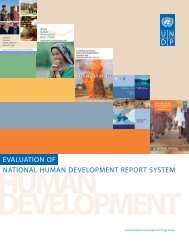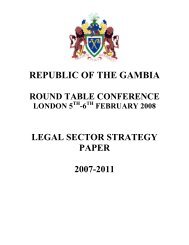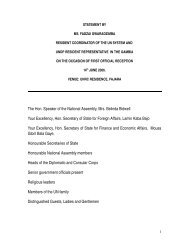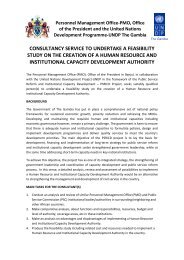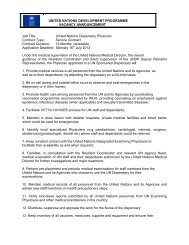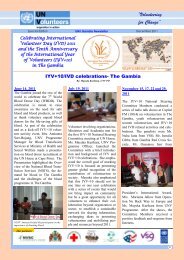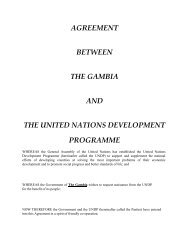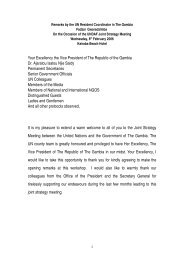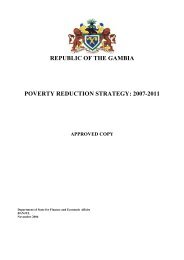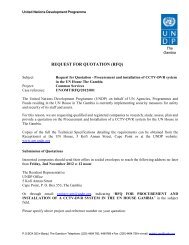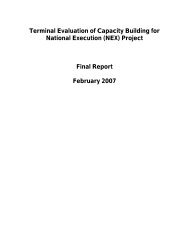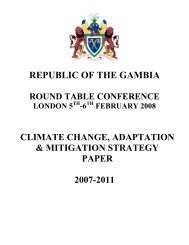Introduction - UNDP The Gambia
Introduction - UNDP The Gambia
Introduction - UNDP The Gambia
Create successful ePaper yourself
Turn your PDF publications into a flip-book with our unique Google optimized e-Paper software.
________________________________________________________________________________________________________________________<br />
In the private sector however, there are very<br />
few women with high-profile positions except<br />
in the banking sector. <strong>The</strong>re is, unfortunately,<br />
not a single woman who heads a bank or a<br />
large private company in this country,<br />
although several are found at the top and<br />
middle management levels. <strong>The</strong>re is a dire<br />
need to increase the empowerment and<br />
participation of women at senior management<br />
cadres.<br />
Reduction of Child Mortality, Improvement<br />
of Maternal Health and Combating against<br />
HIV/AIDS, Malaria and other Diseases: If<br />
the MDGs on health are to be achieved, the<br />
private sector must be encouraged to invest<br />
more in health infrastructure, especially in the<br />
provision of hospitals, health clinics and the<br />
training of health personnel. This should also<br />
include the promotion of the use of traditional<br />
medicine and traditional healers, and the<br />
establishment of traditional healing clinics,<br />
such as the centre set up in Berending in the<br />
North Bank Division, which offers facilities<br />
to outpatients.<br />
Other opportunities that exist in the health<br />
sector for private sector participation include<br />
the provision of health insurance schemes,<br />
catering and food services, laundry and<br />
cleansing services.<br />
Both HIV/AIDS and malaria are killerdiseases<br />
that threaten the <strong>Gambia</strong>n<br />
population. Both are depleting the already<br />
limited human resource base of the country<br />
and if the current rates of infection of both<br />
diseases are not reversed, the labour supply<br />
and the domestic market of the economy will<br />
be adversely affected. This is a threat to the<br />
survival of the private sector.<br />
A reduced mortality rate however assures the<br />
survival of the population, a sustainable pool<br />
of human resources and a domestic consumer<br />
market, which are vital for the development<br />
of the private sector.<br />
Without doubt, private sector participation in<br />
the health sector, as suggested above and<br />
within the context of the opportunities and<br />
challenges offered, would greatly contribute<br />
to the achievement of the MDGs. It is in the<br />
interest of the private sector to promote the<br />
development of a healthy human resource<br />
base for the economy, as an ill population is a<br />
threat to the very survival and viability of a<br />
vibrant private sector or private sector-led<br />
economic development.<br />
Environmental Sustainability: <strong>The</strong>re are<br />
several issues, challenges, opportunities and<br />
constraints in the relationship between<br />
environmental sustainability and private<br />
sector development. First, water supply in<br />
<strong>The</strong> <strong>Gambia</strong> is almost entirely in the hands of<br />
the public domain and, until recently, there<br />
was very little private sector participation.<br />
This situation has changed with the<br />
emergence of Gamwater, a local company<br />
established by a private entrepreneur to bottle<br />
water for the export and domestic markets.<br />
Environmental sustainability also includes<br />
environmental protection and conservation.<br />
<strong>The</strong> private sector is the largest producer of<br />
industrial solid and non-solid wastes, some of<br />
which are highly toxic. <strong>The</strong>se include those<br />
emitted by cement, plastics and soap<br />
factories, breweries, hotels and restaurants,<br />
wholesalers and retailers.<br />
Solid waste disposal, which is yet to be<br />
quantified in terms of daily tonnage disposed,<br />
continues to pose the biggest challenge to<br />
local authorities like the Banjul City Council<br />
and the Kanifing Municipal Council. <strong>The</strong><br />
limited number of dumping sites in the urban<br />
areas and the overflow of garbage in the<br />
neighbourhoods around the dumping sites<br />
continue to be a major threat to the population<br />
located in these areas, such as in the Bakoteh<br />
area and around Banjul.<br />
<strong>The</strong> conflict between private sector land use<br />
and environmental conservation and<br />
preservation is also a threat to the<br />
maintenance of enhanced environmental<br />
sustainability. For example, the current<br />
practice of sand mining along the South<br />
Atlantic coast of the country for the building<br />
and construction industry has caused severe<br />
coastal erosion. It also continues to threaten<br />
the survival of the tourist industry as beaches<br />
and the seaside are the major attraction and<br />
resources of the tourist industry.<br />
________________________________________________________________________________________________<br />
Building Capacity for the Attainment of the Millennium Development Goals in <strong>The</strong> <strong>Gambia</strong> National Human Development Report 2005<br />
27




